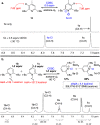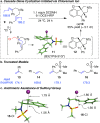A new tool to guide halofunctionalization reactions: the halenium affinity (HalA) scale
- PMID: 25152188
- PMCID: PMC4183602
- DOI: 10.1021/ja506889c
A new tool to guide halofunctionalization reactions: the halenium affinity (HalA) scale
Abstract
We introduce a previously unexplored parameter-halenium affinity (HalA)- as a quantitative descriptor of the bond strengths of various functional groups to halenium ions. The HalA scale ranks potential halenium ion acceptors based on their ability to stabilize a "free halenium ion". Alkenes in particular but other Lewis bases as well, such as amines, amides, carbonyls, and ether oxygen atoms, etc., have been classified on the HalA scale. This indirect approach enables a rapid and straightforward prediction of chemoselectivity for systems involved in halofunctionalization reactions that have multiple nucleophilic sites. The influences of subtle electronic and steric variations, as well as the less predictable anchimeric and stereoelectronic effects, are intrinsically accounted for by HalA computations, providing quantitative assessments beyond simple "chemical intuition". This combined theoretical-experimental approach offers an expeditious means of predicting and identifying unprecedented reactions.
Figures









Similar articles
-
A Mechanistically Inspired Halenium Ion Initiated Spiroketalization: Entry to Mono- and Dibromospiroketals.Angew Chem Int Ed Engl. 2022 Feb 14;61(8):e202115173. doi: 10.1002/anie.202115173. Epub 2022 Jan 11. Angew Chem Int Ed Engl. 2022. PMID: 34881491 Free PMC article.
-
Catalytic, asymmetric halofunctionalization of alkenes--a critical perspective.Angew Chem Int Ed Engl. 2012 Oct 29;51(44):10938-53. doi: 10.1002/anie.201204347. Epub 2012 Sep 25. Angew Chem Int Ed Engl. 2012. PMID: 23011853 Free PMC article. Review.
-
Ritter-enabled catalytic asymmetric chloroamidation of olefins.Chem Sci. 2020 Dec 7;12(5):1834-1842. doi: 10.1039/d0sc05224h. Chem Sci. 2020. PMID: 34163947 Free PMC article.
-
Vilsmeier reaction of 3-aminopropenamides: one-pot synthesis of pyrimidin-4(3H)-ones.J Org Chem. 2011 Apr 15;76(8):2880-3. doi: 10.1021/jo101949y. Epub 2011 Mar 18. J Org Chem. 2011. PMID: 21391701
-
What is the nature of the first-formed intermediates in the electrophilic halogenation of alkenes, alkynes, and allenes?Chemistry. 2003 Mar 3;9(5):1036-44. doi: 10.1002/chem.200390097. Chemistry. 2003. PMID: 12596140 Review.
Cited by
-
Nucleophile-Assisted Alkene Activation: Olefins Alone Are Often Incompetent.J Am Chem Soc. 2016 Jul 6;138(26):8114-9. doi: 10.1021/jacs.6b02877. Epub 2016 Jun 22. J Am Chem Soc. 2016. PMID: 27284808 Free PMC article.
-
Catalytic Chemo-, Regio-, Diastereo-, and Enantioselective Bromochlorination of Unsaturated Systems Enabled by Lewis Base-Controlled Chloride Release.J Am Chem Soc. 2022 Jul 27;144(29):13294-13301. doi: 10.1021/jacs.2c04588. Epub 2022 Jul 12. J Am Chem Soc. 2022. PMID: 35820071 Free PMC article.
-
Computational tools for the prediction of site- and regioselectivity of organic reactions.Chem Sci. 2025 Mar 4;16(13):5383-5412. doi: 10.1039/d5sc00541h. eCollection 2025 Mar 26. Chem Sci. 2025. PMID: 40070469 Free PMC article. Review.
-
Identifying and Engineering Flavin Dependent Halogenases for Selective Biocatalysis.Acc Chem Res. 2024 Aug 6;57(15):2067-2079. doi: 10.1021/acs.accounts.4c00172. Epub 2024 Jul 22. Acc Chem Res. 2024. PMID: 39038085 Free PMC article.
-
Catalytic, Enantioselective Sulfenofunctionalization of Alkenes: Development and Recent Advances.Angew Chem Int Ed Engl. 2020 Nov 2;59(45):19796-19819. doi: 10.1002/anie.202005920. Epub 2020 Aug 18. Angew Chem Int Ed Engl. 2020. PMID: 32452077 Free PMC article. Review.
References
-
- Bose A.; Mal P. Tetrahedron Lett. 2014, 55, 2154.
- Chen J.; Zhou L. Synthesis 2014, 46, 586.
- de Mattos M. C. S. Curr. Org. Synth. 2013, 10, 819.
- Galligan M. J.; Akula R.; Ibrahim H. Org. Lett. 2014, 16, 600. - PubMed
- Getrey L.; Krieg T.; Hollmann F.; Schrader J.; Holtmann D. Green Chem. 2014, 16, 1104.
- Kamei T.; Ishibashi A.; Shimada T. Tetrahedron Lett. 2014, 55, 4245.
- Stodulski M.; Goetzinger A.; Kohlhepp S. V.; Gulder T. Chem. Commun. 2014, 50, 3435. - PubMed
-
- Hiegel G. A.; Nalbandy M. Synth. Commun. 1992, 22, 1589.
- van Summeren R. P.; Romaniuk A.; Ijpeij E. G.; Alsters P. L. Catal. Sci. Technol. 2012, 2, 2052.
-
- Hasty S. J.; Demchenko A. V. Chem. Heterocycl. Compd. 2012, 48, 220. - PMC - PubMed
- Girard N.; Rousseau C.; Martin O. R. Tetrahedron Lett. 2003, 44, 8971.
- Fraser-Reid B.; Lopez C. J.; Gammon D. W.; Sels B. F. In Handbook of Chemical Glycosylation: Advances in Stereoselectivity and Therapeutic Relevance; Demchenko A. V., Ed.; Wiley: 2008; p 381.
-
- In Halogen Bonding: Fundamentals and Applications; Metrangolo P., Resnati G., Eds.; Springer-Verlag Berlin: Berlin, 2008; Vol. 126, p 1.
- Chen G.; Ma S. Angew. Chem., Int. Ed. 2010, 49, 8306. - PubMed
- Castellanos A.; Fletcher S. P. Chem.—Eur. J. 2011, 17, 5766. - PubMed
- Denmark S. E.; Kuester W. E.; Burk M. T. Angew. Chem., Int. Ed. 2012, 51, 10938. - PMC - PubMed
- Hennecke U. Chem.—Asian J. 2012, 7, 456. - PubMed
- Mendoza A.; Fananas F. J.; Rodriguez F. Curr. Org. Synth. 2013, 10, 384.
- Murai K.; Fujioka H. Heterocycles 2013, 87, 763.
- Tan C. K.; Yeung Y.-Y. Chem. Commun. 2013, 49, 7985. - PubMed
- Chen J.; Zhou L. Synthesis 2014, 46, 586.
- Zheng S.; Schienebeck C. M.; Zhang W.; Wang H.-Y.; Tang W. Asian J. Org. Chem. 2014, 3, 366.
Publication types
MeSH terms
Substances
Grants and funding
LinkOut - more resources
Full Text Sources
Other Literature Sources

